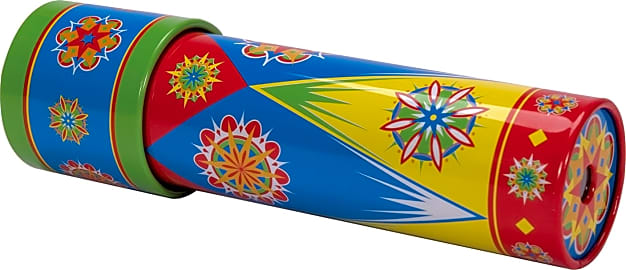The 10 Best Kaleidoscopes

This wiki has been updated 39 times since it was first published in January of 2017. For more than 200 years, kaleidoscopes have dazzled millions of people of all ages, inspiring wonder and joy with their always-changing swirl of colors and shapes. The selections featured here look great both from the outside and when held to the eye. For safety’s sake, if you intend to give one to a child, be sure to comply with the manufacturer’s stated age guidelines. When users buy our independently chosen editorial choices, we may earn commissions to help fund the Wiki.
Editor's Notes
November 20, 2020:
We had to remove the Smartivity Fantastic Optics due to availability concerns, and we also removed the Bits and Pieces Continuous Movement due to complaints regarding cheap materials as well as a general lack of consumer interest. Instead, we added the Haptime Six Pack, which offers more kaleidoscopes for less money than any competitor on the market, making it a great option for party favors or stocking stuffers. We also included the iKeelo Classic, which has the great plus of hiding animals inside its design, giving children something extra to look for.
October 22, 2019:
Whether you’re in the market for a kaleidoscope that’s a children’s toy or an elegant collector’s item, our selection has plenty of choices for you. Featured are designs that make for attractive coffee table adornments, fun party favors, and even ones that will complement certain costumes.
Joining the list today is the Smartivity Fantastic Optics, which rounds out our selection as a fun, DIY kit that will help teach kids some basic STEM principles as they build it. It comes with 131 pieces and a detailed, illustrated instruction booklet. It’s suitable for youngsters who are six years old and up, and takes around 45 minutes to build. Once it’s complete, your child will have an attractive toy that can be placed on a nightstand, desk, or bookshelf in his or her room. Its high-quality materials include nontoxic, engineered wood, plastic, mirrors, and red, green, yellow, and blue panels and beads.
Remaining high on our list is the handcrafted J Devlin Tumble Wheel, which is an eye-catching work of art that will start many a conversation when it’s placed on your desk or coffee table. It features a sapphire-blue stained-glass tube (it’s also available with a green tube) that’s nine inches in length, with a wheel full of glass chips that spins independently of the tube. It makes a great gift for anyone who collects kaleidoscopes or simply appreciates colorful art.
Leaving the list today is the inTemenos Vintage, since it’s no longer available.
On a safety-related note, if you're giving one of these to a child, be sure to comply with the manufacturer's stated age range. For instance, many models contain small parts are are not intended for kids younger than three years of age.
Special Honors
American Flag Kaleidoscope Old Glory adorns the outside of this eye-catching piece, and red, white, and blue beads, marbles, and shells are combined in its liquid-filled chamber. Just turn the end section to see the baubles constantly creating new, mesmerizing patterns. It was created by Carolyn Bennett, who has been making kaleidoscopes since 1978. Additional designs made by the artist include “Monarch,” “Violets,” “Snowflakes,” and “Feathers.” capekaleidoscopes.com
Pearlescent Tower Designed by Nobuko Hashimoto, this scope features a smooth, triangular body with sides of pearlescent stained glass and decorative soldering. Its three-mirror system produces a delicate, three-dimensional sphere. A look inside reveals vibrant jewel tones of ruby red, royal blue, emerald green, and more. This sturdy piece of art measures just under 10 inches in length. nellieblyscopes.com
Inspiring Wonder Through A Very Small Aperture
In order to operate a kaleidoscope, a person holds the instrument up to a light source, looks into its eyepiece, and rotates the outer tube.
The ability to recognize the colors, shapes, and sizes of various objects is something that most humans learn from a very young age. Many of the fundamental building blocks of learning include elements of joy and wonder, exposing young minds to possibilities, while helping those minds develop an appreciation for things that are always changing and unexpected. This might help to explain why kids love to experiment with toys, why they construct elaborate objects out of everyday items, and why they create their own stories to make sense of the world around them as they grow. Furthermore, the experience of being mesmerized by an image or pattern ultimately transcends childhood. There are few better ways to illustrate these points than through the visually-hypnotic appeal and wonder of a kaleidoscope.
Similar in shape to a telescope, the kaleidoscope is an optical instrument consisting of both a viewing tube and an object box. At the end of the viewing tube is an eyepiece made up of either a lens for magnification or a simple glass through which a user looks. The object box is thin, flat, and constructed of two glass discs with a band circling the discs' edges to hold them in place. The outer disc is ground, allowing for the diffusion of any light that enters the instrument. Also located inside the object box are small, reflective fragments of brightly-colored beads, crystals, glass, seashells, or pebbles that move around freely when the kaleidoscope is shaken or turned. The instrument also leverages several (typically three) rectangular mirrors inside the viewing tube that are arranged at either 45 or 60-degree angles in relation to one another. These mirrors form an equilateral triangle, which allows for multiple reflections of the object fragments.
In order to operate a kaleidoscope, a person holds the instrument up to a light source, looks into its eyepiece, and rotates the outer tube. This rotation causes the reflective objects inside to tumble randomly, their refracted light falling into the path of the mirrors. By reflecting the movements of these colored fragments with each rotation, the mirrors create symmetrical and mosaic-like sets or patterns of varying shapes and colors for the viewer, no two of which are ever identical from one turn to the next.
Centering The Mind, Body, and Spirit
While kaleidoscopes can be considered toys often associated with childhood, they also provide a wide variety of benefits to anybody who uses them. The instrument is considered a "form of art for the body, mind, and spirit". This makes a lot of sense, considering that its use of colors produces a calming and focusing effect. Doing so essentially helps to cleanse the mind of many distractions, while enhancing a person's ability to organize information by looking at a defined geometric pattern.
By contrast, glass or stained-glass instruments can make attractive showpieces in almost any den or man cave.
By rotating a kaleidoscope and changing its patterns, a viewer can become an active participant in the formation of the art itself, which engages both the left and right brain and keeps a person focused, relaxed, and capable of thinking creatively. Diverse wavelengths of colors are also thought to have significant healing powers for the human body. That said, the randomness of color patterns generated by a kaleidoscope provides a form of therapy to those who may feel emotionally unbalanced or troubled. I can certainly attest to having viewed certain types of images or collections of colors when I was a child as a way of clearing my head and forgetting about the stress of the day.
Because the kaleidoscope is essentially a piece of art and a toy all in one, your choice really depends on who the instrument is for and what it's intended purpose will be. If you're purchasing one for a young child as a gift, you'll want to find one constructed from inexpensive, yet relatively durable materials, such as wood, brass, or plastic. Additionally, some kaleidoscopes come with their own removable glitter wands, which makes them fun and easy for little ones to enjoy. By contrast, glass or stained-glass instruments can make attractive showpieces in almost any den or man cave.
A Brief History Of The Kaleidoscope
Scottish inventor Sir David Brewster is credited with the development of the first kaleidoscope in 1815, following his prior experiments on light polarization. The name of the instrument comes from the Greek words kalos, meaning beautiful; eidos, meaning form; and scopos, meaning watcher, so the kaleidoscope is literally defined as a "beautiful form watcher." The instrument was eventually patented in 1817. Brewster's early design also leveraged polyangular mirrors, which allowed viewers to adjust the angles of the mirrors themselves.
Brewster's early design also leveraged polyangular mirrors, which allowed viewers to adjust the angles of the mirrors themselves.
Kaleidoscopes became quite popular in the Victorian era as a parlor diversion. Charles G. Bush was the first person to begin mass manufacturing parlor kaleidoscopes in the United States. One of his many improvements to Brewster's design was the addition of liquid-filled glass capsules that could be viewed as objects inside the instruments.
By the middle of the 20th century, the kaleidoscope was considered less of an elegant statement for parlor rooms and more of a child's toy. The Steven Manufacturing Company became one of the most well-known toy kaleidoscope manufacturers in 1946, and the company still makes them to this day. Most of the company's instruments are made from cardboard or plastic.
The period between the 1970s and 1990s is often referred to as the Kaleidoscope Renaissance, which was at least partially inspired by Cozy Baker, founder of the Brewster Society, and also by the instrument's use as an art form in general. During this period of time, the exteriors of many kaleidoscopes were fashioned from any combination of materials, including alabaster, hand-blown glass, wine and beer bottles, and even motorcycle parts. Increasingly complex mirror arrangements have been developed for the instrument's interior since 2000.
Today, the kaleidoscope is seen as a versatile object that functions as a toy, while also representing superior craftsmanship and artistic creativity from the inside out.



